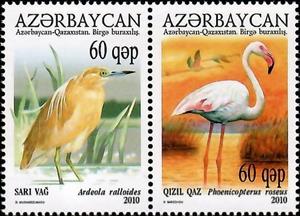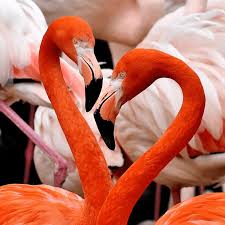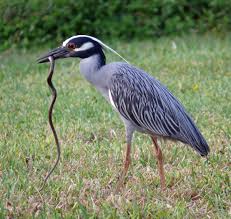Se-tenant: Greater Flamingo (Phoenicopterus roseus) (Azerbaijan 2010)
Greater Flamingo (Phoenicopterus roseus) (Azerbaijan 2010)
24 November (Azerbaijan ) within release Ecology of Caspian Sea - Birds goes into circulation Se-tenant Greater Flamingo (Phoenicopterus roseus) face value 2*60 Azerbaijani qəpik
| Se-tenant Greater Flamingo (Phoenicopterus roseus) in catalogues | |
|---|---|
| Michel: | Mi: AZ 832A-833A |
| Stanley Gibbons: | Sg: AZ 779a |
Se-tenant is horizontal format.
Issued in panes containing four se-tenant pairs. Designs printed checkerboard allowing various horizontal and vertical combinations. Joint issue - Azerbaijan and Kazakhstan. Kazakhstan Mi:KZ 690-691.Also in the issue Ecology of Caspian Sea - Birds:
- Se-tenant - Greater Flamingo (Phoenicopterus roseus) face value 2*60;
- Souvenir Sheet - Ecology of Caspian Sea - Birds face value 8*60;
Se-tenant Greater Flamingo (Phoenicopterus roseus) it reflects the thematic directions:
Animals are multicellular, eukaryotic organisms of the kingdom Animalia (also called Metazoa). All animals are motile, meaning they can move spontaneously and independently, at some point in their lives. Their body plan eventually becomes fixed as they develop, although some undergo a process of metamorphosis later on in their lives. All animals are heterotrophs: they must ingest other organisms or their products for sustenance.
Birds (Aves), a subgroup of Reptiles, are the last living examples of Dinosaurs. They are a group of endothermic vertebrates, characterised by feathers, toothless beaked jaws, the laying of hard-shelled eggs, a high metabolic rate, a four-chambered heart, and a strong yet lightweight skeleton. Birds live worldwide and range in size from the 5 cm (2 in) bee hummingbird to the 2.75 m (9 ft) ostrich. They rank as the class of tetrapods with the most living species, at approximately ten thousand, with more than half of these being passerines, sometimes known as perching birds. Birds are the closest living relatives of crocodilians.
Environmental protection is the practice of protecting the natural environment by individuals, groups and governments.Its objectives are to conserve natural resources and the existing natural environment and, where it is possible, to repair damage and reverse trends.
Flamingos or flamingoes (/fləˈmɪŋɡoʊz/) are a type of wading bird in the family Phoenicopteridae, which is the only extant family in the order Phoenicopteriformes. There are four flamingo species distributed throughout the Americas (including the Caribbean), and two species native to Afro-Eurasia.
Herons are long-legged, long-necked, freshwater and coastal birds in the family Ardeidae, with 72 recognised species, some of which are referred to as egrets or bitterns rather than herons. Members of the genera Botaurus and Ixobrychus are referred to as bitterns, and, together with the zigzag heron, or zigzag bittern, in the monotypic genus Zebrilus, form a monophyletic group within the Ardeidae. Egrets do not form a biologically distinct group from herons, and tend to be named differently because they are mainly white or have decorative plumes in breeding plumage. Herons, by evolutionary adaptation, have long beaks.
A joint issue is the release of stamps or postal stationery by two or more countries to commemorate the same topic, event or person. Joint issues typically have the same first day of issue and their design is often similar or identical, except for the identification of country and value.





